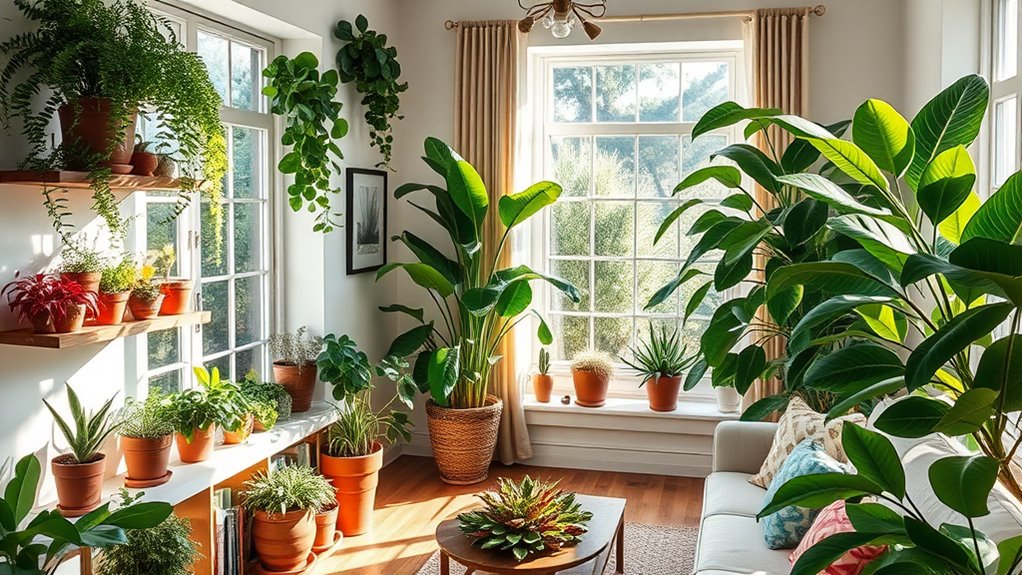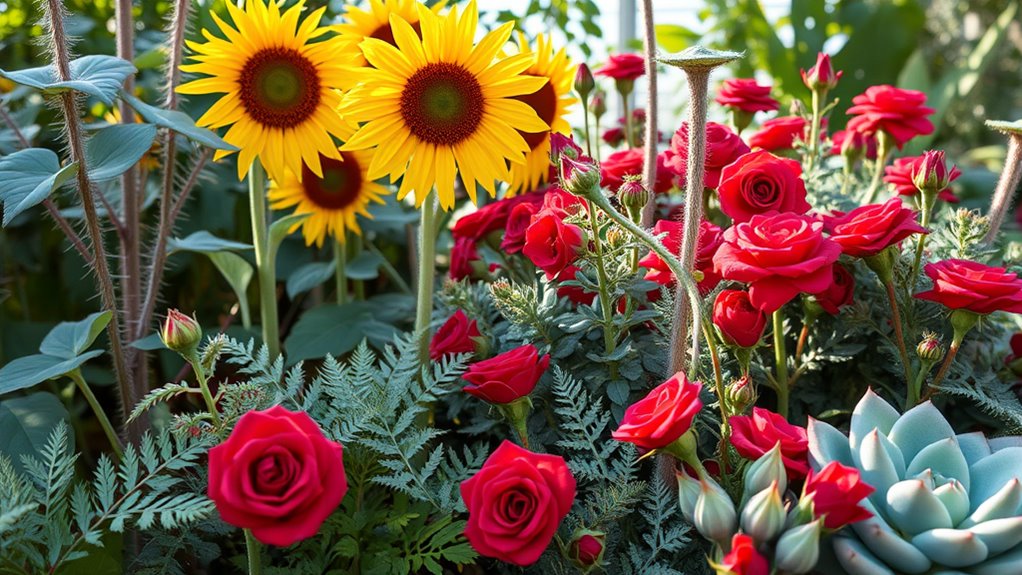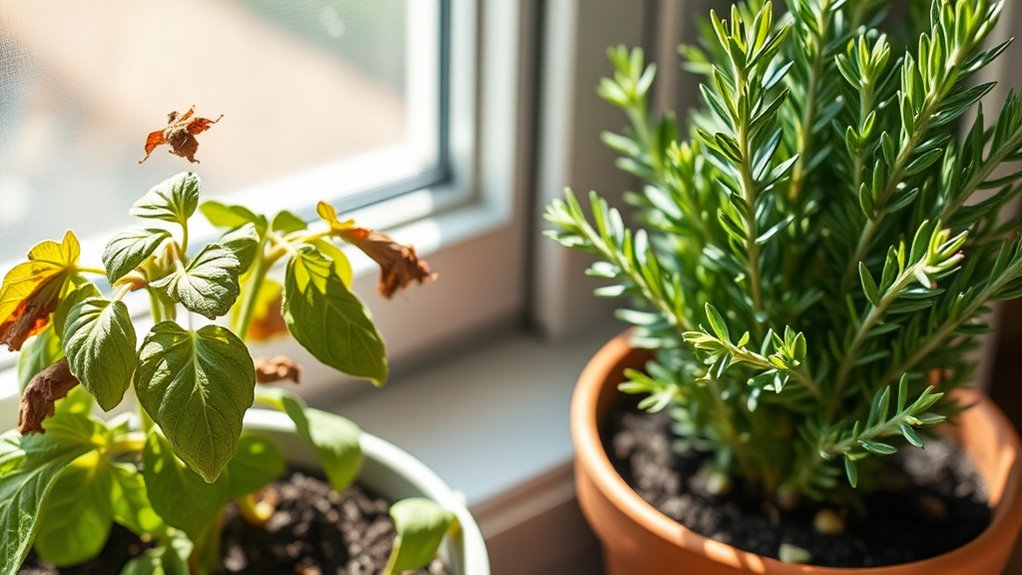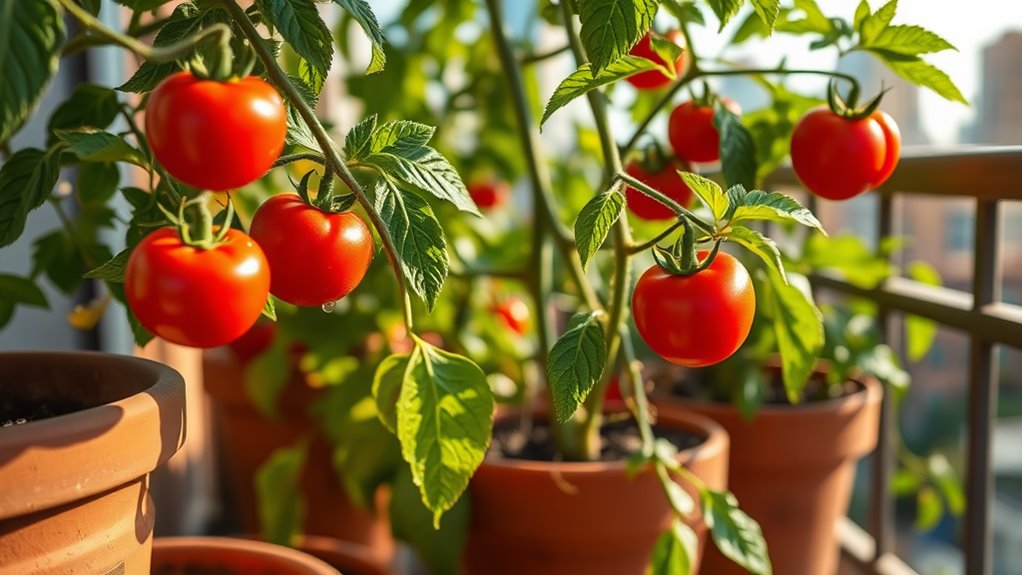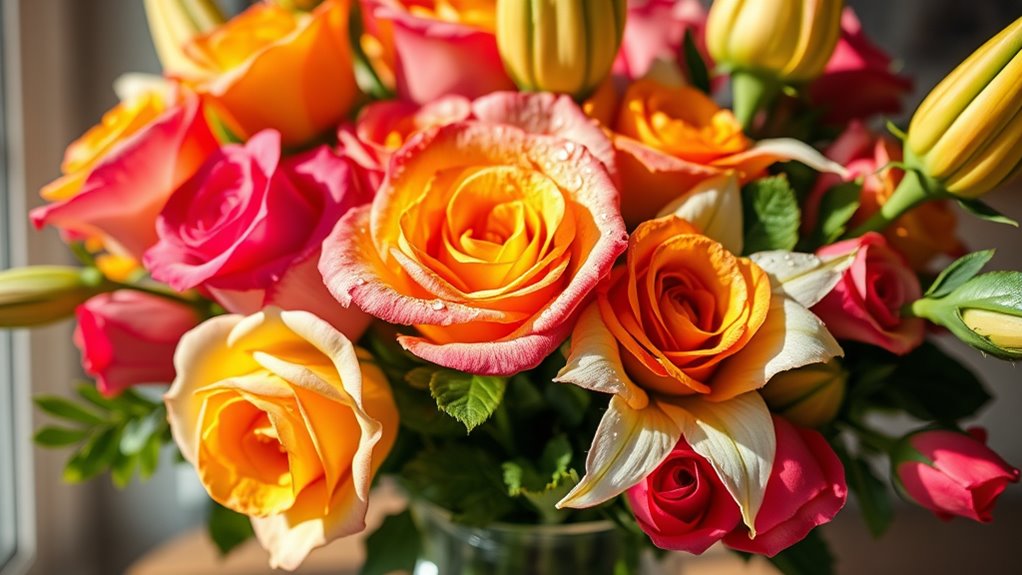How to Turn Any Indoor Space Into a Green Paradise
You’ll transform any indoor space into a green paradise by selecting resilient plants suited to your light, humidity, and temperature, like easy-care varieties that boost air quality. Arrange them with strategic spacing for optimal air flow and visual appeal, using height variations and groupings to mimic natural ecosystems. Optimize light through rotation and supplements, while maintaining routines like soil moisture checks and pruning. Explore creative designs and advanced techniques next for even greater success.
Key Takeaways
- Select plants based on light, humidity, and ease of care to build a thriving indoor garden.
- Position plants according to their light needs and rotate them for even growth and health.
- Establish routine care like regular watering, fertilizing, and pest checks to maintain vitality.
- Design layouts with vertical or modular arrangements to maximize space and visual appeal.
- Use advanced techniques like hydroponics and LED lights to enhance growth in small indoor areas.
Choosing the Right Plants
When you’re creating an indoor green space, start by selecting plants that match your environment’s conditions, such as light levels, humidity, and temperature. For beginners, consider incorporating easy-care indoor plants that are resilient and suitable for novice gardeners.
To optimize your indoor plant layout, assess each species’ growth habits and spatial needs, ensuring they fit without overcrowding. Choose scientifically suited options like pothos for low-light tolerance or peace lilies for moisture-rich settings.
Evaluate maintenance factors, including watering frequency and pest resistance, to sustain vitality. Prioritize native or adaptive varieties that enhance air quality and biodiversity, fostering a thriving, balanced indoor ecosystem.
Always cross-reference reliable sources for accurate plant profiles.
Additionally, incorporate plants that have been supported by scientific studies to maximize their air-purifying benefits.
Arranging Plants Effectively
Once you’ve chosen your plants, arrange them strategically to optimize light exposure, airflow, and visual appeal, ensuring each thrives in its spot.
By considering growth habits and room dynamics, you’ll foster a balanced ecosystem that boosts plant health and aesthetics. This approach maximizes vitality while preventing issues. To enhance your indoor garden, consider adding flavorful herbs that thrive in containers.
Follow these key strategies:
-
Group similar plants together to form supportive microclimates that enhance overall vitality and promote mutual growth.
-
Maintain adequate distances between plants to facilitate air circulation, minimize disease risk, and ensure each gets its share of resources.
-
Use height variation and foliage contrast to achieve a visually appealing arrangement that draws the eye and creates a dynamic focal point.
Additionally, drawing from essential aspects of indoor gardening, always prioritize plant selection to ensure your chosen plants are well-suited for the available conditions and long-term success.
Optimizing Light and Placement
To optimize your indoor green space, you first assess the natural light in each area by noting its intensity and duration, which directly influences plant health.
Then, you position plants strategically based on their light requirements, ensuring they thrive without overcrowding.
Finally, you incorporate artificial lighting where needed, selecting full-spectrum LEDs to supplement low-light conditions and support photosynthesis.
Assess Natural Light
How do you accurately assess natural light in your indoor space? Start by observing the sun’s path and measuring its intensity to ensure your plants thrive. This scientific approach helps you identify optimal spots without guesswork.
-
Measure light levels: Use a lux meter to quantify brightness; aim for 1,000-5,000 lux for most houseplants.
-
Track daily variations: Monitor sunlight hours in each area, noting morning versus afternoon exposure for accurate data.
-
Evaluate seasonal changes: Observe how light shifts with seasons, adjusting for shorter winter days to maintain consistency.
Strategic Plant Placement
Strategic plant placement maximizes your plants’ access to assessed light levels, ensuring they thrive in your indoor space.
First, categorize your plants by light needs—high, medium, or low—based on your earlier assessment. Position high-light plants near south-facing windows for optimal exposure, while placing shade-tolerant species in dimmer corners to prevent scorching.
Rotate pots periodically to promote even growth and avoid uneven light distribution. Factor in room layout; elevate shorter plants on stands to capture light without blocking others.
This precise arrangement enhances photosynthesis, reduces stress, and fosters a balanced ecosystem in your green haven.
Use Artificial Lighting
While natural light may not always suffice, you’ll find that supplementing it with artificial sources effectively bridges the gap for your indoor plants.
Artificial lights replicate the sun’s spectrum, delivering essential wavelengths for photosynthesis and growth, especially in low-light environments.
To optimize light and placement, follow this:
-
Select full-spectrum LED lights* for their *energy efficiency and precise delivery of red and blue wavelengths, maximizing photosynthetic activity without excessive heat.
-
Position lights strategically at 6-12 inches above plants to ensure uniform coverage, preventing leaf burn while promoting even growth.
-
Use timers for consistency to simulate natural day-night cycles, regulating photoperiods and supporting healthy development in your green space.
Essential Care Routines
Maintaining essential care routines keeps your indoor green space vibrant and healthy. You’ll monitor soil moisture to water correctly, apply fertilizers judiciously, prune for optimal growth, and inspect for pests regularly. These steps prevent issues like root rot or infestations, ensuring plants thrive scientifically.
| Care Routine | Key Guidelines |
|---|---|
| Watering | Check soil; water when dry |
| Fertilizing | Use balanced mix every 4-6 weeks |
| Pruning | Remove dead growth monthly |
| Pest Monitoring | Inspect and treat bi-weekly |
Adopt these routines to sustain your paradise efficiently. Additionally, incorporate effective indoor pest control techniques to maintain healthy, pest-free indoor plants. To enhance growth further, ensure your plants receive optimal light for better photosynthesis and vitality.
Creative Layout Designs
You’ve established essential care routines for your indoor plants, so now turn your attention to creative layout designs that enhance space and aesthetics. Additionally, consider plant selection to choose species that complement your arrangements and thrive in your indoor conditions.
Explore vertical garden layouts to utilize wall space effectively, modular plant arrangements to adapt configurations as needed, and hanging display ideas to add dimension overhead.
These strategies enable you to integrate greenery innovatively while maintaining a balanced ecosystem. Additionally, by incorporating indoor herb growing into your designs, you can enjoy fresh and flavorful herbs for year-round cooking.
Vertical Garden Layouts
When designing vertical garden layouts, you’ll maximize your indoor space by incorporating creative designs that blend functionality with aesthetics.
These layouts optimize light exposure and airflow, turning walls into thriving ecosystems while promoting plant health.
-
Incorporate staggered shelving****: You stack plants at varying heights to create depth, ensuring each receives optimal sunlight and preventing overcrowding for better growth rates.
-
Use geometric patterns*: Arrange planters in spirals or grids to enhance visual interest, allowing efficient water drainage and reducing pest accumulation through *strategic airflow.
-
Integrate with architecture: Mount gardens on unused walls or columns, merging them with your space’s structure to boost biodiversity and improve humidity levels scientifically.
Modular Plant Arrangements
Modular plant arrangements build on vertical designs by letting you customize setups with interchangeable components that adapt to your space’s needs.
You’ll select modular units like stackable shelves or adjustable frames, ensuring optimal light exposure and airflow for plant health.
Experiment with grid-based layouts to maximize floor space, incorporating sensors for moisture and nutrients to maintain scientific precision.
This approach enhances biodiversity; mix species for symbiotic growth, boosting air quality.
Regularly reconfigure elements to evolve your paradise, promoting efficient resource use and preventing stagnation in confined areas.
Track progress to refine your design dynamically.
Hanging Display Ideas
Hanging display ideas let you maximize vertical space with creative, adaptable layouts that suspend plants from ceilings or walls, enhancing light exposure and air circulation for healthier growth.
You’ll create dynamic visuals that transform mundane areas into vibrant oases, using materials like lightweight pots and sturdy hooks for stability.
-
Macramé Hangers: Attach trailing plants like pothos to woven hangers; they promote even moisture distribution and add bohemian charm.
-
Wall-Mounted Shelves: Install tiered systems for ferns; this optimizes photosynthesis by angling leaves toward natural light sources.
-
Ceiling Grids: Suspend multiple species on adjustable grids; it facilitates airflow, reducing fungal risks while creating layered depth.
Maximizing Small Spaces
How do you efficiently turn a compact area into a lush indoor garden?
Begin by choosing compact, low-maintenance plants like ferns or succulents that fit tight spaces without overwhelming them. These resilient indoor plants can withstand neglect and still flourish.
You’ll optimize vertical real estate using wall-mounted pots or multi-tiered shelves, creating layers for maximum greenery.
Position plants strategically to ensure adequate light and air circulation, drawing on basic botanical principles for healthy growth.
Employ modular organizers to rotate specimens easily, promoting even development.
Measure space precisely to avoid overcrowding, fostering a balanced ecosystem that thrives in small confines.
For busy lifestyles, consider incorporating effortless indoor plants that require minimal care to enhance your space effortlessly.
Advanced Growth Techniques
As you master basic setups, you’ll implement advanced growth techniques like hydroponics and LED supplementation to optimize plant development.
These methods boost efficiency by targeting key biological processes. To further enhance your indoor garden’s sustainability, consider incorporating sustainable fertilizing methods that utilize natural, homemade alternatives for nutrient-rich soil.
-
Adopt hydroponics: Deliver precise nutrient solutions directly to roots, minimizing waste and accelerating growth rates in confined spaces.
-
Incorporate LED lighting*: Select spectrally tuned LEDs to enhance *photosynthesis, reducing energy use while maximizing chlorophyll production.
-
Fine-tune environmental factors: Use sensors to monitor and adjust pH, humidity, and CO2 levels, ensuring plants thrive under scientific parameters.
To integrate sustainable practices, consider applying organic gardening hacks that promote thriving plants in your indoor setup.

